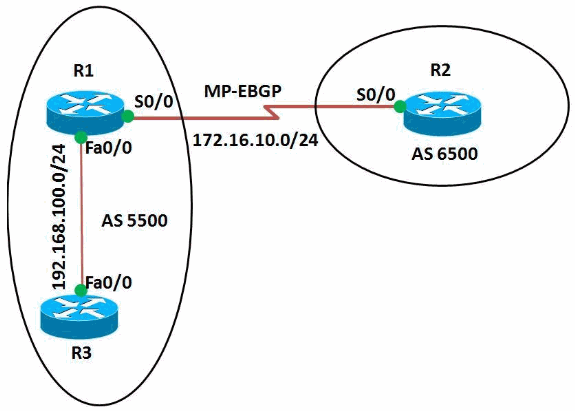Introduction
This document provides information how to configure multiprotocol extended Border Gateway Protocol (MP-EBGP) in Cisco IOS routers. MP-BGP is an extended BGP that allows BGP to carry routing information for multiple network layer protocols IPv6, VPNv4, and others. MP-BGP allows you to have a unicast routing topology different from a multicast routing topology, which helps to control the network and resources.
Components Used
This document is not restricted to specific software and hardware versions.
The configurations in this document are based on the Cisco 3700 series router that runs Cisco IOS® Software Release 12.4 (15)T 13.
Configure
In this example, the R1 and R3 routers are configured to be in AS 5500 forming iBGP. The R2 router is configured to be in AS 6500. The R1 and R2 routers communicate with each other using MP-EBGP. All the routers are configured with loopback addresses.
Network Diagram
This document uses this network setup:
Configurations
Router R1
R1#show run Building configuration... ! version 12.4 ! hostname R1 ! ip cef ! ! interface Loopback0 ip address 10.10.10.10 255.255.255.0 ! interface FastEthernet0/0 ip address 192.168.100.10 255.255.255.0 duplex auto speed auto ! interface Serial0/0 ip address 172.16.10.1 255.255.255.0 mpls ip clock rate 2000000 ! router bgp 5500 no synchronization bgp router-id 10.10.10.10 bgp log-neighbor-changes network 192.168.100.0 redistribute connected neighbor 172.16.10.2 remote-as 6500 neighbor 172.16.10.2 soft-reconfiguration inbound neighbor 192.168.100.11 remote-as 5500 no auto-summary ! address-family vpnv4 neighbor 172.16.10.2 activate neighbor 172.16.10.2 send-community both !--- Sends the community attribute to a BGP neighbor. exit-address-family ! ! end
Router R2
R2#show run Building configuration... ! version 12.4 ! hostname R2 ! ip cef ! ip vrf WAN rd 2020:1 route-target export 2020:1 route-target import 2020:1 ! !interface Loopback0 ip vrf forwarding WAN !--- Associates a VRF instance with an interface or subinterface. ip address 20.20.20.20 255.255.255.255 ! interface Serial0/0 ip vrf forwarding WAN ip address 172.16.10.2 255.255.255.0 mpls ip clock rate 2000000 ! router bgp 6500 no synchronization bgp router-id 20.20.20.20 bgp log-neighbor-changes neighbor 172.16.10.1 remote-as 5500 no auto-summary ! ! address-family vpnv4 neighbor 172.16.10.1 activate neighbor 172.16.10.1 send-community both exit-address-family ! address-family ipv4 vrf WAN redistribute connected redistribute static neighbor 172.16.10.1 remote-as 5500 neighbor 172.16.10.1 activate no synchronization exit-address-family ! ! ! endRouter R3R3#show run Building configuration... ! version 12.4 ! hostname R3 ! ip cef ! ! ! interface Loopback0 ip address 11.11.11.11 255.255.255.255 ! interface FastEthernet0/0 ip address 192.168.100.11 255.255.255.0 duplex auto speed auto ! router bgp 5500 no synchronization bgp router-id 11.11.11.11 bgp log-neighbor-changes neighbor 192.168.100.10 remote-as 5500 no auto-summary ! endVerify
In order to display entries in the (BGP) routing table, use the show ip bgp command.In router R2, use the show ip bgp vpnv4 command to display (VPNv4) address information from the (BGP) table.MP-EBGP is established between the R1 and R2 routers. Use the ping command to verify the reachability from R1 to R2 and vice versa.





No comments:
Post a Comment